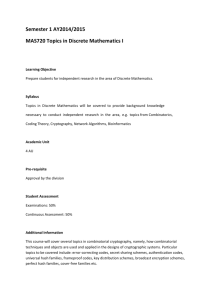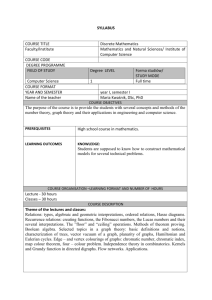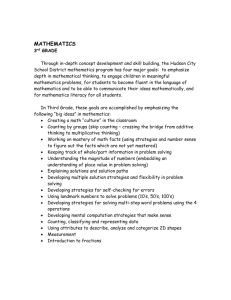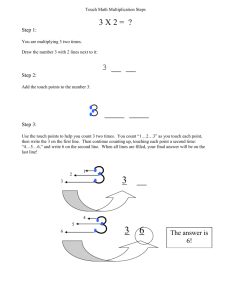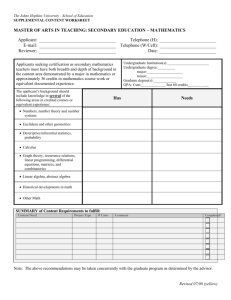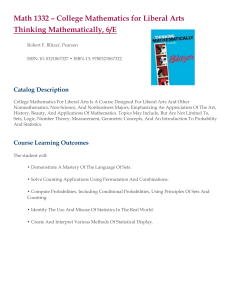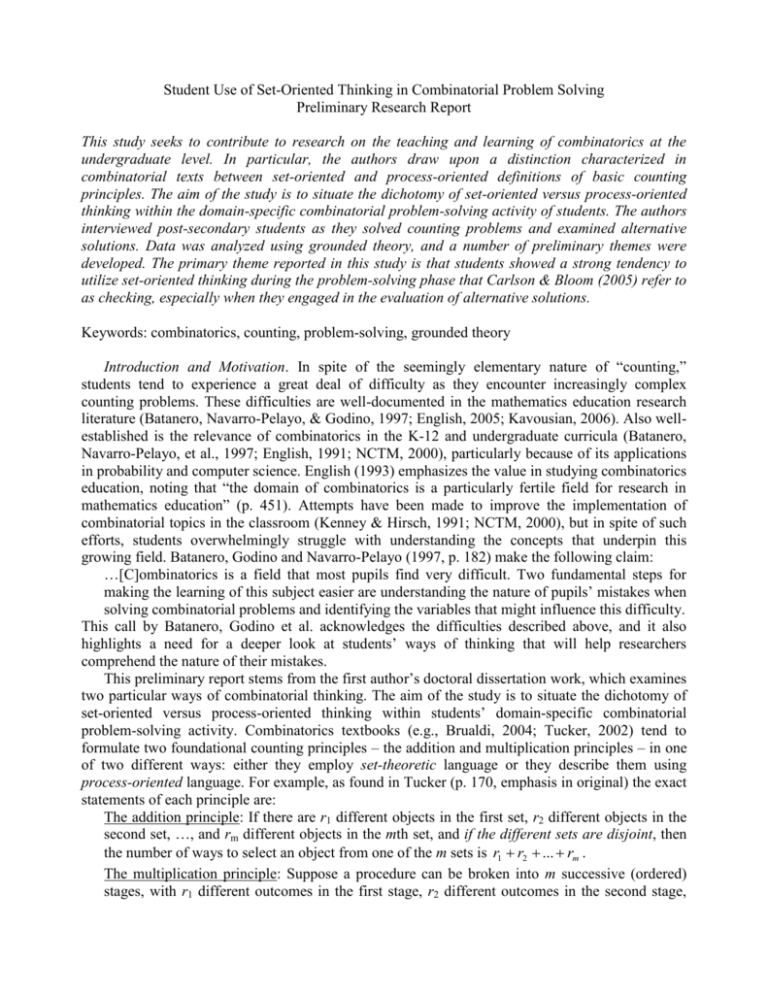
Student Use of Set-Oriented Thinking in Combinatorial Problem Solving
Preliminary Research Report
This study seeks to contribute to research on the teaching and learning of combinatorics at the
undergraduate level. In particular, the authors draw upon a distinction characterized in
combinatorial texts between set-oriented and process-oriented definitions of basic counting
principles. The aim of the study is to situate the dichotomy of set-oriented versus process-oriented
thinking within the domain-specific combinatorial problem-solving activity of students. The authors
interviewed post-secondary students as they solved counting problems and examined alternative
solutions. Data was analyzed using grounded theory, and a number of preliminary themes were
developed. The primary theme reported in this study is that students showed a strong tendency to
utilize set-oriented thinking during the problem-solving phase that Carlson & Bloom (2005) refer to
as checking, especially when they engaged in the evaluation of alternative solutions.
Keywords: combinatorics, counting, problem-solving, grounded theory
Introduction and Motivation. In spite of the seemingly elementary nature of “counting,”
students tend to experience a great deal of difficulty as they encounter increasingly complex
counting problems. These difficulties are well-documented in the mathematics education research
literature (Batanero, Navarro-Pelayo, & Godino, 1997; English, 2005; Kavousian, 2006). Also wellestablished is the relevance of combinatorics in the K-12 and undergraduate curricula (Batanero,
Navarro-Pelayo, et al., 1997; English, 1991; NCTM, 2000), particularly because of its applications
in probability and computer science. English (1993) emphasizes the value in studying combinatorics
education, noting that “the domain of combinatorics is a particularly fertile field for research in
mathematics education” (p. 451). Attempts have been made to improve the implementation of
combinatorial topics in the classroom (Kenney & Hirsch, 1991; NCTM, 2000), but in spite of such
efforts, students overwhelmingly struggle with understanding the concepts that underpin this
growing field. Batanero, Godino and Navarro-Pelayo (1997, p. 182) make the following claim:
…[C]ombinatorics is a field that most pupils find very difficult. Two fundamental steps for
making the learning of this subject easier are understanding the nature of pupils’ mistakes when
solving combinatorial problems and identifying the variables that might influence this difficulty.
This call by Batanero, Godino et al. acknowledges the difficulties described above, and it also
highlights a need for a deeper look at students’ ways of thinking that will help researchers
comprehend the nature of their mistakes.
This preliminary report stems from the first author’s doctoral dissertation work, which examines
two particular ways of combinatorial thinking. The aim of the study is to situate the dichotomy of
set-oriented versus process-oriented thinking within students’ domain-specific combinatorial
problem-solving activity. Combinatorics textbooks (e.g., Brualdi, 2004; Tucker, 2002) tend to
formulate two foundational counting principles – the addition and multiplication principles – in one
of two different ways: either they employ set-theoretic language or they describe them using
process-oriented language. For example, as found in Tucker (p. 170, emphasis in original) the exact
statements of each principle are:
The addition principle: If there are r1 different objects in the first set, r2 different objects in the
second set, …, and rm different objects in the mth set, and if the different sets are disjoint, then
the number of ways to select an object from one of the m sets is r1 r2 ... rm .
The multiplication principle: Suppose a procedure can be broken into m successive (ordered)
stages, with r1 different outcomes in the first stage, r2 different outcomes in the second stage,
…, and rm different outcomes in the mth stage. If the number of outcomes at each stage is
independent of the choices in the previous stages and if the composite outcomes are all distinct,
then the total procedure has r1 r2 ... rm different composite outcomes.
In Tucker’s definition of the addition principle, his language involves sets explicitly. The definition
reflects a fundamental conception of counting as the enumeration of the number of objects in a set.
In his definition of the multiplication principle, however, counting is framed as the completion of a
task consisting of successive stages. Other authors reflect this distinction as well; some (e.g.,
Brualdi, 2004; Rosen, 2007) include two different definitions of each principle, one in terms of sets,
and the other in terms of processes.
This dichotomy in the way mathematicians present these basic principles suggests that a
relevant distinction could be manifested in student approaches to counting problems. The literature
does not address this issue – only a handful of studies in combinatorics education (English, 1991;
Hadar & Hadass, 1981) refer to the distinction between sets and processes at all, but no study has
explicitly addressed this phenomenon and its potential bearing on students’ counting. Noticing this
distinction between sets and processes has led the authors to study whether these two formulations
indicate any differences in the ways students think about and approach counting problems.
Design and methodology. In designing the study, based on her experiences, the first author
suspected that students may draw more heavily on set-oriented thinking when asked to justify
whether an answer is right or wrong. Therefore, in an attempt to narrow the scope, she purposefully
put students in situations in which they had to evaluate alternative solutions (thus engaging in error
detection and correction). Furthermore, for efficiency, she focused on counting problems that are
commonly susceptible to errors – problems that have incorrect solutions that frequently seem
correct to students. Problems were drawn from Martin (2001) and Tucker (2002).
In the study reported here, eight students were interviewed individually in two 60-90 minute,
videotaped sessions. The students were drawn from an upper-division mathematics courses at a
large urban university and included mathematics majors, computer science majors, and postbaccalaureate students. In order to accomplish the goals above, the general interview protocol was
as follows. In Interview 1, the subjects were given five to seven counting problems and were
instructed to solve them as they naturally would (some talked with the author during this time,
others were silent). Then, they were asked to explain their thought process and were posed
questions about their work. At no point in either interview were they told whether or not a given
answer was correct. In Interview 2, students were given alternative answers to the same problems
they had solved in Interview 1. They were asked to evaluate the new answers, explore how the new
answer compared to their original answer, and determine which answer they thought was correct.
The videotape of each interview was viewed repeatedly and transcribed. The methodological
framework of grounded theory (Strauss & Corbin, 1998; Auerbach & Silverstein, 2003) was
implemented in order to code the data. Coding consisted of the initial identification of repeated
ideas (Auerbach & Silverstein, Ibid) and phenomena, which were then consolidated into themes
related to the set/process distinction. The authors also drew upon Carlson & Bloom’s (2005)
problem solving cycle (which consists of four major stages: orienting, planning, executing, and
checking) for analysis purposes. Coding thus took place along two dimensions: based on
phenomena that the authors observed and categorized, and according to the problem-solving stages
put forth by Carlson & Bloom.
Results. Preliminary analysis of the data indicates promising themes about the occurrences of
set- and process-oriented thinking as students solve counting problems. In some contexts, there does
indeed seem to be some correlation between the types of counting activity students carry out as they
draw upon certain kinds of thinking. The primary theme reported in this study is that students show
a strong tendency toward set-oriented thinking during the checking problem-solving phase,
particularly when they engage in the evaluation of alternative solutions. Specifically, there is
evidence of students categorizing an answer as incorrect by identifying a particular object that was
counted more than once. Additionally, there are cases in which students identified two different
answers as the same when they evaluated the process – it was not until they adopted a set-oriented
perspective that they could explain the different numerical results.
While not all of these findings may be explored in this proposal, an example of student work on
one problem is discussed below. The Test Questions problem states A student must answer five out
of ten questions on a test, including at least two of the first five questions. How many subsets of five
questions can be answered? One solution to this problem utilizes a case breakdown, based on
whether exactly two, three, four, or five of the first five questions are answered, yielding
5 5 5 5 5 5 5 5
5 8
. A common incorrect answer is , which is
2 3 3 2 4 1 5 0
2 3
obtained by first choosing two of the first five questions to answer, and then choosing any three of
the eight remaining questions to answer. The rationale behind such a solution is that the “at least
two” constraint is satisfied in the first step, and thus any remaining choice of three problems will
still satisfy the constraint of the problem. The trouble with this strategy, however, is that some of
the possible outcomes can be counted more than once. For example, in utilizing this strategy,
suppose problems 1 and 2 are chosen as the first step. Then, in the next step, problems 3, 7 and 8 are
chosen as the second step. Thus, the subset of five questions to be answered is {1, 2, 3, 7, 8}.
However, this subset could be found in a different way using the same counting strategy, namely,
by first choosing problems 1 and 3, and then choosing problems 2, 7, 8. Thus, the expression
5 8
actually counts some solutions more than once and is therefore incorrect. If the students
2 3
solved this problem correctly initially, they were given the common incorrect answer in Interview 2.
If they first arrived at an incorrect answer, they were asked to examine the correct solution.
Don was a student who displayed both set and process-oriented thinking at various times. In the
excerpt below, while working on the Test Questions problem Don decides that the incorrect
expression is too big. In justifying this belief, he appeals to two sets of questions generated by the
5 8
incorrect attempt that are in fact the same. That is, in order to show that is incorrect, he
2 3
identifies a particular set of questions (a1, a2, a3, a9, a10) that is counted more than once.
Don: And so let’s see I have, we’ll call them a1 and a2 [he writes down the numbers as he’s
talking], and then I also have a3, a9, and a10. But then, add up all these combinations again, you
know next time I might have a1, and a3, and then a2 and a9 and a10, and, so this is the same,
and this [the incorrect attempt] um, perhaps doesn’t account for that.
Don’s response reflects that, on some level, he was able to view the counting process as the
enumeration of objects – he is counting objects in a set, and he identified one object that was
counted too many times. Set-oriented thinking was his chosen way of justifying to himself that the
incorrect attempt was too big.
Conclusion. The study described here suggests that students draw upon set-oriented thinking
during particular moments in their combinatorial problem solving. These findings stand to inform
current understandings of student thinking about counting, offering a meaningful contribution to the
field of mathematics education. Subsequent research will include an additional round of data
collection based on the preliminary themes identified in this study. The authors will continue to
examine the data and make connections among themes that emerge in the new data set, coordinating
new and existing themes appropriately. The first author also hopes to conduct further studies that
address similar issues, perhaps investigating ways in which combinatorial mathematicians view the
domain specific set versus process dichotomy.
Questions:
1) Is the distinction between sets and processes, as it relates to combinatorics, a relationship
that teachers of combinatorics have noticed?
2) In what ways can the process-oriented thinking, as specified here, be related to other themes
in mathematics education (such as students’ notions of functions)?
3) For what other areas of combinatorics and discrete mathematics might this distinction be
relevant, and in what ways?
4) What would a domain-specific problem-solving framework for combinatorics look like?
References
Auerbach, C. & Silverstein, L. B. (2003). Qualitative data: An introduction to coding and analysis.
New York: New York University Press.
Batanero, C., Godino, J., & Navarro-Pelayo, V. (1997). Combinatorial reasoning and its assessment.
In I. Gal & J. B. Garfield (Eds.), The Assessment Challenge in Statistics Education (pp. 239252): IOS Press.
Batanero, C., Navarro-Pelayo, V, & Godino, J. D. (1997). Effect of the implicit combinatorial
model on combinatorial reasoning in secondary school pupils. Educational Studies in
Mathematics, 32, 181-199.
Brualdi, R. A. (2004). Introductory Combinatorics (4th ed.). Upper Saddle River, New
Jersey: Pearson Prentice Hall.
Carlson, M & Bloom, I. (2005) The cyclic nature of problem solving: An emergent
multidimensional problem-solving framework. Educational Studies in Mathematics, 58, 4575.
English, L. D. (1991). Young children’s combinatorics strategies. Educational Studies in
Mathematics, 22, 451-474.
English, L.D. (2005). Combinatorics and the development of children’s combinatorial reasoning. In
G.A. Jones (Ed.), Exploring probability in school: Challenges for teaching and learning.
Kluwer, Academic Publishers, 40, 121-141.
Hadar, N., & Hadass, R. (1981). The road to solve combinatorial problems is strewn with pitfalls.
Educational Studies in Mathematics, 12, 435-443.
Kenney, M. J., & Hirsch, C. R. (Eds.). (1991). Discrete mathematics across the curriculum, K-12:
1991 Yearbook. Reston, VA: National Council of Teachers of Mathematics.
Kavousian, S. (2008) Enquiries into undergraduate students’ understanding of combinatorial
structures. Unpublished doctoral dissertation, Simon Fraser University – Vancouver, BC.
Martin, G. E. (2001). The Art of Enumerative Combinatorics. New York: Springer.
National Council of Teachers of Mathematics. (2000). Principles and standards for school
mathematics. Reston, VA: Author.
Rosen, K. H. (2007). Discrete Mathematics and Its Applications (6th ed.). New York: McGraw Hill.
Strauss, A. & Corbin, J. (1998). Basics of Qualitative Research: Techniques and Procedures for
Developing Grounded Theory (2nd ed.). Thousand Oaks, California: Sage Publications, Inc.
Tucker, A. (2002). Applied Combinatorics (4th ed.). New York: John Wiley & Sons.

